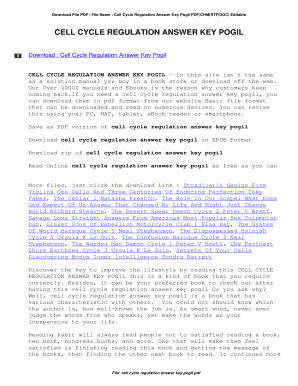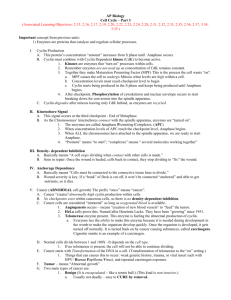Cell Cycle Regulation Pogil Answers
Cell Cycle Regulation Pogil Answers
Cell Cycle and Regulation: Explained

The cell cycle is a series of events that take place in a cell leading to its division and duplication. It involves multiple phases that are tightly regulated to ensure proper cell growth and division. Understanding cell cycle regulation is crucial, as abnormalities can lead to severe health conditions, including cancer.
The Importance of Cell Cycle Regulation

Proper cell cycle regulation is essential to maintain the balance between cell growth and cell division. It ensures that cells replicate their DNA accurately, divide appropriately, and avoid uncontrolled proliferation. Here are some key aspects of cell cycle regulation:
- Checkpoint Control: Checkpoints are critical control points during the cell cycle that determine whether a cell is ready to proceed to the next phase. These checkpoints monitor DNA integrity, DNA replication, and the presence of growth factors.
- Cyclins and Cyclin-Dependent Kinases (CDKs): Cyclins and CDKs are proteins that act as key regulators of the cell cycle. They form complexes that control the progression of the cell cycle by phosphorylating specific target proteins.
- Tumor Suppressor Genes: Tumor suppressor genes, such as p53, play a crucial role in cell cycle regulation. They can halt the cell cycle to allow DNA repair or induce cell death (apoptosis) if DNA damage is irreparable.
Common Questions about Cell Cycle Regulation
Here are answers to some frequently asked questions about cell cycle regulation:
1. What are the different phases of the cell cycle?
The cell cycle consists of four main phases: G1 (Gap 1), S (Synthesis), G2 (Gap 2), and M (Mitosis). During G1, the cell grows and prepares for DNA replication. In the S phase, DNA replication occurs, leading to the duplication of genetic material. G2 phase is a second growth phase, allowing the cell to prepare for division. Finally, during the M phase, the cell undergoes mitosis, dividing its genetic material and cytoplasm into two daughter cells.
2. How are cyclins and CDKs involved in the cell cycle?
Cyclins are proteins that regulate the progression of the cell cycle by binding to and activating CDKs. CDKs, on the other hand, are enzymes that phosphorylate target proteins, thereby controlling various aspects of the cell cycle, including DNA replication and entry into mitosis.
3. What happens if cell cycle regulation is disrupted?
If cell cycle regulation is disrupted, it can lead to severe consequences. Uncontrolled cell division can result in the formation of tumors and cancer. Additionally, inadequate cell growth and division can lead to developmental disorders and impaired tissue regeneration.
Conclusion
Cell cycle regulation is a complex process that ensures the proper growth and division of cells. It involves various checkpoints, proteins, and genes that work together to maintain cell homeostasis. Understanding cell cycle regulation is crucial in identifying mechanisms that can be targeted for therapeutic interventions in diseases like cancer.
Sources:
1. "Cell Cycle Regulation Pogil Answer Key - Perfect Docs" 2. "Cell Cycle Regulation Pogil Key Pdf - Fill Online, Printable, Fillable"
FAQs
Q: Is cell cycle regulation important?
A: Yes, cell cycle regulation is crucial for maintaining the balance between cell growth and division and avoiding abnormal cell proliferation.
Q: What are the key players in cell cycle regulation?
A: Cyclins, cyclin-dependent kinases (CDKs), and tumor suppressor genes are some of the key players in cell cycle regulation.
Q: What happens during the G1 phase of the cell cycle?
A: In the G1 phase, the cell grows and prepares for DNA replication.
Q: How do cyclins and CDKs control the cell cycle?
A: Cyclins bind to CDKs, forming complexes that phosphorylate target proteins and regulate various stages of the cell cycle.
Q: What are the consequences of disrupted cell cycle regulation?
A: Disrupted cell cycle regulation can lead to conditions like cancer, developmental disorders, and impaired tissue regeneration.
Q: Where can I find more information about cell cycle regulation?
A: For more information, you can refer to scientific journals, textbooks, or consult with a knowledgeable healthcare professional.
Disclaimer: The information provided here is for educational purposes only and should not be considered as professional medical advice. Please consult with a healthcare professional for personalized guidance related to cell cycle regulation and related topics.
Cell Cycle Regulation Worksheet Answer Key Pogil Worksheet : Resume
 Image Source : www.thesecularparent.com
Image Source : www.thesecularparent.com cycle cell answer key worksheet mitosis sequencing regulation biology pogil
Cell Cycle Regulation Pogil Key Pdf - Fill Online, Printable, Fillable
 Image Source : www.pdffiller.com
Image Source : www.pdffiller.com cycle cell pogil key regulation answer pdffiller
Cell Size Pogil Answers | Amulette
cell pogil size answers
Cell Cycle POGIL | Mitosis | Cell Biology
 Image Source : pt.scribd.com
Image Source : pt.scribd.com pogil
⭐ Pogil The Cell Cycle Answer ⭐ - Pollycraft Monday
 Image Source : pollycraftmonday.blogspot.com
Image Source : pollycraftmonday.blogspot.com The Cell Cycle Worksheet Answer Key Pogil
 Image Source : myans.bhantedhammika.net
Image Source : myans.bhantedhammika.net Cell Cycle Regulation
 Image Source : studylib.net
Image Source : studylib.net cell cycle regulation biology ap outline part
Cell Cycle Regulation Pogil Answer Key - Perfect Docs
 Image Source : perfectdocpdf.blogspot.com
Image Source : perfectdocpdf.blogspot.com regulation pogil organelles grows proteins
⭐ pogil the cell cycle answer ⭐. Cell pogil size answers. Cell cycle regulation pogil answer key. Cell cycle regulation pogil key pdf. Cycle cell answer key worksheet mitosis sequencing regulation biology pogil